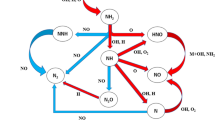Abstract
The effect of the addition of nitric oxides (NO and NO2) on rich hydrogen-air flames was studied using the tracer method in numerical simulation. It is shown that the effects of these additives are not similar. Both oxides promote the formation of OH and H2O in the low-temperature zone of the front. The addition of NO reduces the first maximum of the OH profile and the burning velocity. The addition of NO2 increases the first maximum of the OH profile and does not change the burning velocity.
Similar content being viewed by others
References
A. A. Konnov, J. N. Zhu, J. H. Bromly, and D. Zhang, “The effect of NO and NO2 on the partial oxidation of methane: Experiments and modeling,” Proc. Combust. Inst., 30, 1093–1100 (2005).
G. Dayma, K. H. Ali, and Ph. Dagaut, “Experimental and detailed kinetic modeling study of the high pressure oxidation of methanol sensitized by nitric oxide and nitrogen dioxide,” Proc. Combust. Inst., 31, 411–418 (2007).
Ph. Dagaut and A. Nicolle, “Experimental and detailed kinetic modeling of the effect of exhaust gas on fuel combustion: mutual sensitization of the oxidation of nitric oxide and methane over extended temperature and pressure ranges,” Combust. Flame, 140, 161–171 (2005).
A. S. Sokolik, Self-Ignition, Flame, and Detonation in Gases [in Russian], Izd. Akad. Nauk SSSR, Moscow (1960).
R. F. Sawyer and I. Glassman, “The reactions of hydrogen with nitrogen dioxide, oxygen, and mixtures of oxygen and nitric oxide,” Proc. Combust. Inst., 20, 469–479 (1969).
F. E. Scott, R. W. Van Dolah, and M. G. Zabetakis, “Flammability characteristics of the system H2-NO-N2O-air,” Proc. Combust. Inst., 6, 540–545 (1957).
V. N. Kondratev, Kinetics of Chemical Gas Reactions [in Russian], Izd. Akad. Nauk SSSR, Moscow (1958).
V. A. Bunev and V. S. Babkin, “Effect of propylene additives on rich hydrogen-air flames,” Mendeleev Commun., No. 2, 104–105 (2006).
V. A. Bunev and V. S. Babkin, “Limits of the propagation of a flame for single-component oxidizers,” Combust., Expl., Shock Waves, 13, No. 3, 397–398 (1977).
V. V. Zamashchikov and V. A. Bunev, “Estimation of the efficiency of inhibitors acting on combustion of gases,” Combust., Expl., Shock Waves, 37, No. 4, 378–386 (2001).
F. Liu, H. Guo, and G. J. Smallwood, “The chemical effect of CO2 replacement of N2 in air on the burning velocity of CH4 and H2 premixed flames,” Combust. Flame, 133, No. 4, 495–497 (2003).
V. A. Bunev, A. V. Baklanov, I. G. Namyatov, V. V. Zamashchikov, and V. S. Babkin, “Tracer method in numerical simulation of combustion processes,” Combust., Expl., Shock Waves, 43, No. 6, 619–627 (2007).
R. J. Kee, J. F. Grcar, M. D. Smooke, and J. A. Miller, “PREMIX: A Fortran program for modeling laminar one-dimensional premixed flames,” Sandia National Laboratories Report No. SAND85-8240 (1985).
R. J. Kee, F. M. Rupley, and J. A. Miller, “CHEMKIN-II: A Fortran chemical kinetics package for the analysis of gas phase chemical kinetics,” Sandia National Laboratories Report No. SAND 89-8009B (1989).
G. P. Smith et al., GRI-Mech 3.0 (1999). http://www.me.berkeley.edu/grimech/version30/text30.html.
V. A. Bunev, I. G. Namyatov, and V. S. Babkin, “Mechanism of inhibition of flame hydrogen by propane,” Khim. Fiz., 26, No. 9, 39–45 (2007).
F. Joubert, D. Desbordes, and H.-N. Presles, “Detonation cellular structure in NO2/N2O4-fuel gaseous mixtures,” Combust. Flame, 152, 482–495 (2008).
W. G. Parker and H. G. Wolfhard, “Some characteristics of flames supported by NO and NO2,” Proc. Combust. Inst., 4, 420–428 (1953).
Author information
Authors and Affiliations
Corresponding author
Additional information
__________
Translated from Fizika Goreniya i Vzryva, Vol. 45, No. 3, pp. 19–25, May–June, 2009.
Rights and permissions
About this article
Cite this article
Bunev, V.A. Numerical simulation of the effect of the addition of NO and NO2 on a rich hydrogen flame using the tracer method. Combust Explos Shock Waves 45, 251–257 (2009). https://doi.org/10.1007/s10573-009-0033-5
Received:
Revised:
Published:
Issue Date:
DOI: https://doi.org/10.1007/s10573-009-0033-5



